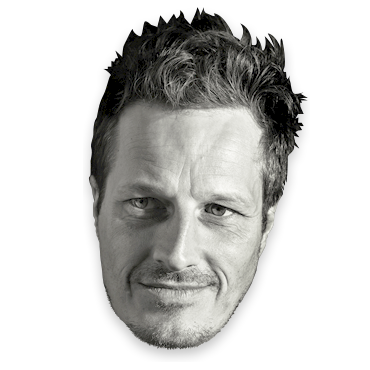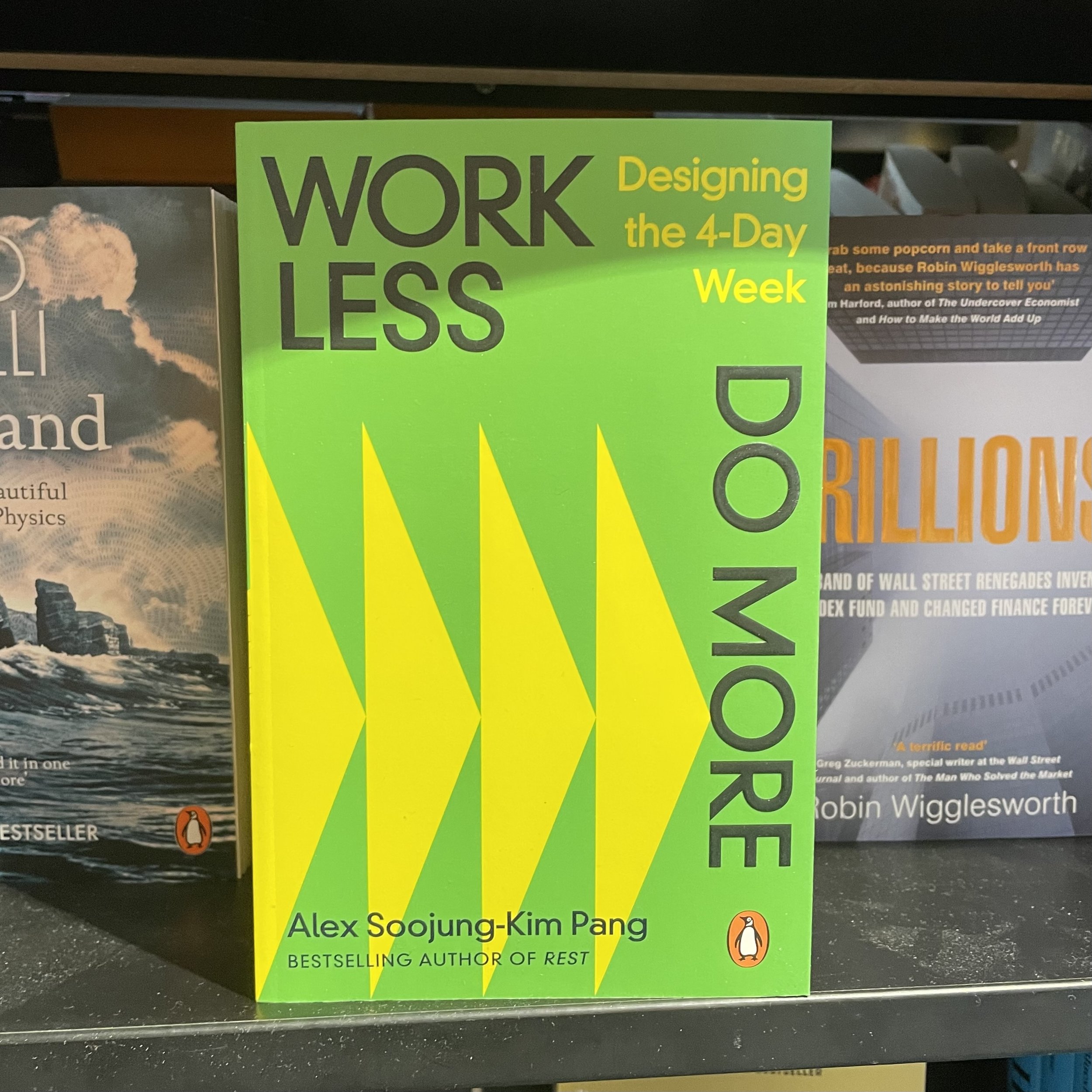monochrome face of a spotted-tailed quoll
Art Monday: back on the circular brushstrokes
Returning to and extending a piece I did ~3 years ago. Trying for a painterly feel in under 100 lines of JavaScript, uses p5js.
New edition of “Work Less, Do More” is out, with a better cover
Flying back from Queenstown in NZ, I saw a new edition of Alex Soojung-Kim Pang’s Work Less, Do More: Designing the 4-Day Week, which used to be called Shorter.
Alex interviewed me for it c. 2019, and I talked at length about how we did the 4-day week at Icelab.
From the archives [2014]: a speculative interview about public transport
Interviewer: Kerry Ingram, thanks for talking to us. You’ve been the CEO of Transport for Canberra for five years now, and it’s been a very exciting five years for the organisation and for the city. The first thing that people from outside notice, of course, is that the TfC network is free.
Ingram: That’s right. In almost every other public transport network, there’s either full or partial cost-recovery via tickets. Its very hard to make public transport profitable, though: the more you charge, the less accessible it is, and the fewer people use the service. Even with pricing set to maximise income, we only used to derive about 20% of our revenue from ticketing. That’s a significant chunk of money, to be sure, but we also spent a significant amount of money installing and maintaining machines, running the ticketing network, enforcing compliance and so on.
The first and most important thing I wanted to do when I entered this job was to eliminate fares. Money’s strange: a dollar here is exactly the same as a dollar there. But people don’t necessarily see it that way. Some services, like roads, are provided “free” by the government, while others – like the old bus services – were user-pays – except in this case, the user was only paying less than a quarter of the full cost. So it’s always been subsidised to a large percentage – we just made that percentage 100.
Dropping fares cost about $25 million, but what we bought with that is far more valuable. We bought access throughout the city as a right for citizens, something which they could expect, in the same way as they expect the streets to be lit, garbage to be collected, fires to be extinguished. Put that way, not making transport free would be perverse.
Collecting fees – the ticketing, the the compliance – itself costs money and time and hassle. Going free means we save that money (none of which helped people travel on our network), but it also means that we make our services faster to board, easier to use, and much more widely available to all members of the community, no matter what their financial status.
But that’s not how everyone saw it.
Sure. We had a backlash from those those stood to lose money, particularly taxi drivers and even the operators of pay parking in the city. The taxi operators had a point: governments in the past had derived significant revenue from selling taxi licenses as exorbitant rates. We ended up buying back those licenses and folding taxi services into the TfC network. There were also cranky letter writers whose basic objection, when you you boiled it down, was to “subsidising” poor people, as if they themselves had paid directly for all the government services they use.
Once we went free, there was a huge increase in network use: it was pretty hard to meet the demand at first, but people understood there’d be growing pains. Now, we’d never go back to the old way: free transport is a defining characteristic of our city. You’re overseas and mention you’re from Canberra and people ask about it. Going free means it’s normalised: public transport isn’t just for people who can’t drive, it’s for everyone. When we became an independent for-benefit corporation, I didn’t want its direction set by the usual bunch of middle-aged businesspeople, people like myself. Canberra’s citizens are shareholders and stakeholders, and I’m responsible to a board which is demographically proportional to our population: we have schoolchildren, young parents, older Canberrans, students, as well as workers of all kinds. We encourage people to contribute their ideas, their energy, their perspectives to the way we work.
How much is it worth to live in a connected community, one where everyone from every walk of life has the same access to the city? How much is it worth to have residents the outer suburbs able to get to work, to play, to visit their families without having to pay extra? And having a popular transport network also means we can have a pervasive network. More people use it to go more places every year. We’re continually extending the network, making it better, faster, more accessible.
It’s a very different network now, compared to five years ago.
Absolutely. I came on board as the head of ACTION: the ACT Internal Omnibus Network. That name specified a mode of transport: naturally, that limited the scope of its ambitions. Changing the name to Transport for Canberra wasn’t just an exercise in rebranding: it reconfigured our thinking around what we’re here for. We’re not in the bus business: we’re in the transport business. We should be mode-agnostic. Today, most users of our network use at least two different vehicles each trip – typically an electric microbus to the nearest local hub, then an express vehicle – tram, train, bus – to a regional centre.
Switching to microbuses for that first five kilometres was a no-brainer. Big buses are great for moving fifty, a hundred people, and above that number, trains excel. But big buses are noisy, they don’t take corners well, and they accelerate and decelerate badly, which is exactly what you don’t want when you’re picking up passengers every few hundred metres. The electric microbuses are cheaper to run and easier to maintain – and they use green energy, so it’s a win all around.
The new network – and the organisation which runs it - is– much more flexible, more responsible, more able to cope with shifting demands. Requesting a microbus via smartphone and knowing the exact moment it’ll be there beats standing in the rain waiting for a big bus to come and pick you up. We track every trip via face-recognition, so we know who’s going where. Better data leads to better decisions: our systems can predict demand and meet it efficiently. We’re seeing people use the network outside of normal times, to do things that they never would have done before. Groups of friends call up a microbus and go out to dinner: picking people up and dropping them home is part of the night.
What’s next, then?
We’re going to see further diversification in our vehicle fleet. Usage patterns are notoriously lumpy: we get much more traffic at the start and end of the working day, of course, but weather and school holidays and major events all feed into it. Ideally we’ll always be able to meet demand. We’re looking at bringing in casual, on-demand microbuses or even smaller vehicles, owned privately, which will be available when required to meet peak needs. A semiretired person might do a couple of hours at each end of the day, making contacts with their local community and earning some money while they’re at it. A uni student could go out late on a Friday night and be the designated driver for their whole suburb.
We’re seeing some unexpected benefits too, with our shift to electric vehicles. Deciding to build the vehicles ourselves rather than going out to tender has literally electrified our engineering and maintenance teams: we’re getting orders from other cities for vehicles of their own, and there’s a growing cottage industry of people renting the workshops and our peoples’ skills after-hours, to do their own electric vehicle conversions. We’re not only the free-transport city: we’re now the electric vehicle city.
We don’t have the infrastructure for it yet, but I’m also interested in how an electric fleet can help power our homes and our workplaces. Most of our vehicles are still idle for much of the time: they could be feeding power back into the grid, heating our buildings, making our energy network more flexible, more resilient. Further out, I imagine autonomous, self-driving vehicles will make a big impact: salary costs are three-quarters of our budget. If we could save that money, we could move a lot more people…
Interesting times. Thanks for talking to us.
Thank you.







